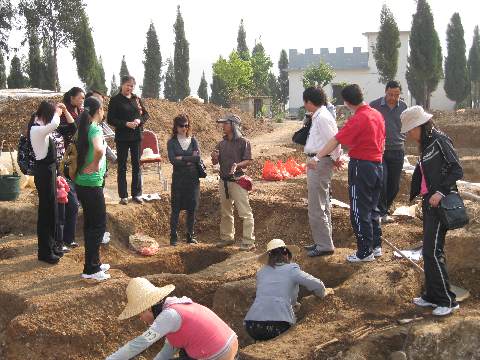
Lijiashan Ancient Tombs in Jiangchuan is a key national-level cultural relics preservation unit with major aristocratic tombs of ancient Dian Kingdom. The discovery of the tombs in 1992 was named "10 most important archaeological discoveries of the year". The ancient Dian Kingdom lasted from War Period to early Han Dynasty. In 1966, the cultivation by local villagers destroyed part of the tombs located at the surface. In 1972, the archaeological team of Yunnan made first excavation. In 1989, the tombs were listed on the county-level cultural relics preservation. In 1991 and 1992, a second excavation was conducted. In 1993, the site was put on the list of province-level cultural relics preservation unit and in 2001, the national-level preservation unit.

There are two pieces large flat lands in Jiangchuan with Xingyun Lake lying in the center. Lijiashan is a hill in Jiangchen Township, one of the flat lands. The hill is not big and the top of it is flat with the whole body looking like a chair with a backrest. The tombs excavated in the second time were from late Western Han Dynasty, but the size of the tombs and the quantities of burial articles all exceed the tombs of the same type in early Western Han Dynasty, which shows that the noble class of slavery system in middle and late Western Han Dynasty in Dian still possessed high social and economic status. Lijiashan is one of the three major aristocratic tomb sites of ancient Dian Kingdom and it is known at home and abroad for its size, quantities and quality of unearthed relics. The relics include rich materials that reflect splendid cultural achievements of ancient Dian Kingdom with high scientific value.
The tombs occupy an area of 2.5 square kilometers with a sphere of 40,663 square meters. They mainly scatter on the top of the hill and its south-western slope with all the tombs being vertical soil hole burials. The hill has Duoyi Mountain at its back and Xingyun Lake in front of it with hot spring on its foot. In the two excavations, 85 tombs were cleaned with about 3,400 articles including bronze wares, silver and gold wares, jades and agates. Of all the unearthed articles, the Bull-Tiger Bronze Table from tomb M24 represents the aesthetic value of ancient Dian people. The table is 76 cm long and 43 cm high with two bulls and one tiger in its sculpture. Other representative articles include “waving shell saving ware”, “three-knight copper drum”, and “two mating cattle”. These articles are in unique forms with vivid images, exquisite ornamentation, and skillful making, which shows certain connection with arts in central China while keeping unique Dian style.
Admission Fee:¥0

You will only receive emails that you permitted upon submission and your email address will never be shared with any third parties without your express permission.
